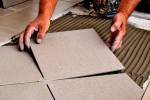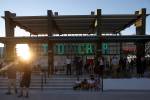Shelves can transform ordinary hallway into vacation hall of fame
I can't believe it, but summer's almost over. One sure sign is that the school buses are rolling. (Sorry kids!) Don't you wish you could just bottle up some of that summer feeling?
Well, here's a suggestion that will help you remember those wonderful days of vacation every day of the year.
Now you probably know that my co-host, Shari Hiller, is a decorator extraordinaire. No space is too small or too insignificant for her to decorate, and according to Shari, accessories are a must.
But I had my doubts when Shari suggested that we decorate a hallway. A hallway? Come on!
Well, Shari was right (again.)
The addition of crown molding shelves, vacation pictures and souvenirs, transformed a purely functional hallway into a vacation hall of fame. If you'd like a hall of fame in your house, these crown molding shelves are a great way to display your favorite vacation mementos.
First decide what the length and width of your shelf will be. The materials listed will create a 7-foot long, 9-inch deep shelf.
To prepare the top part of the shelf, set your circular saw for a 35-degree angle and mark the length and width. Realize that once you add the crown molding, you will be adding half an inch to the depth and one inch to the length.
Then, follow your markings and cut a 35-degree angle around three sides of the board. The bottom of the shelf needs to be cut 11/2 inches narrower and 3 inches shorter than the top piece, because of the angle of the crown molding. Don't angle these cuts; just make them straight with the circular saw.
Cut the back spacer out of the 2 x 4 by cutting it in half to create two 2 x 2s. Then for the front spacer, cut the face of the other 2 x 2 on the same 35-degree angle as the top shelf edge. This will add support for the crown molding and the shelf. If both spacers are about 6 feet long, that will do the trick.
To assemble the hollow shelf, start by laying the top of the shelf upside down on the bench.
Center and line up the front support piece flush with the bevel edge of the top.
Drill pilot holes into the support piece and, using drywall screws, attach the front support to the underneath side of the top.
Then, line up the bottom of the shelf, drill pilot holes and nail the bottom to the front support piece (you may want to set the back spacer in place to make attaching the front edge easier).
Cut the crown molding to size. Then, drill very small pilot holes to help keep it from splitting as it's added around the three sides. Countersink the nails (don't fill the holes up yet), sand the entire piece smooth with a 220-grit sandpaper, wipe with a tack rag, then add a sanding sealer to help even out the stain.
Once it's dry, add the desired stain followed up with a couple of coats of polyurethane.
To install the shelf, begin by finding the wall studs. Mark them with tape, and draw a level line three-quarters of an inch lower than where you want the top of the shelf. This is where the back support will be mounted, and you must leave space for the thickness of the top shelf.
Drill pilot holes that coincide with your wall studs into the 2 x 2 spacer/mounting board. Using lag bolts, screw the mounting board to the wall. Once secure, add decorative brackets three-quarters of an inch below the mounting board, and then slide the hollow shelf over the mounting board.
When everything is centered and even, drill pilot holes into the shelf and down into the support board. Using a countersink bit, create space so the screw heads sink into the top. Then screw in the shelf securely to the wall. Finally, use matching wood putty to fill in all of the holes.
Tip: Fill holes on stained projects after the entire project is finished, and then match the putty to the stain. If you putty the holes and then stain, the putty looks discolored.
Now for the fun part. On a cold day next winter, set up your favorite beach chair in your personal vacation hall of fame. Sit back, relax, and let those vacation memories take you back to summer.
Matt Fox and Shari Hiller, authors of "Matt and Shari's Great Weekend Projects," also appear together frequently on HGTV. For more on ideas or information, visit www.hgtv.com or www.mattandshari.com. Their column is syndicated by Scripps Howard News Service.























